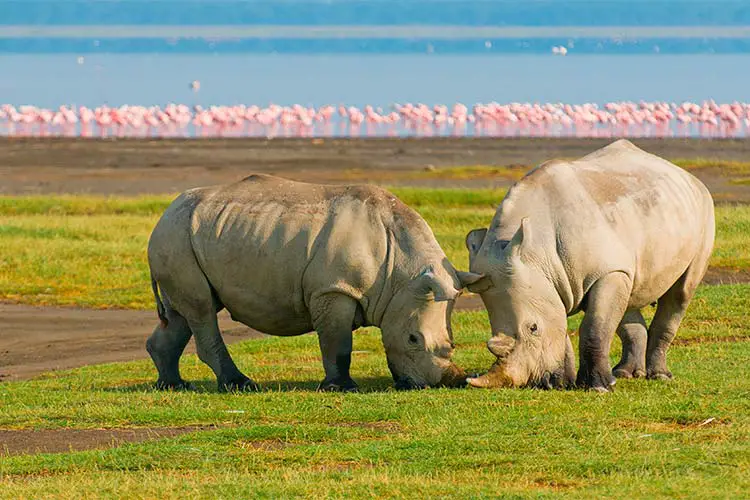East Africa
Numerous countries make up the region of East Africa, including Kenya, Somalia, Ethiopia, Malawi, Uganda, Rwanda, Sudan, Madagascar, Tanzania, and at least 10 others. Despite the huge amount of sovereign states, many of the countries in this region share a number of similarities. Scientific evidence typically claims that the modern Homo sapiens originated somewhere in East Africa, most likely in Ethiopia some 200,000 years ago. It took quite a bit of time for these early humans to advance technologically, but many scholars cite the implementation of agriculture sometime around 7000 BCE as an important milestone in the path towards civilization.
Though several kingdoms were established soon after this, very little is known of these early people, especially in comparison to the Bantu peoples. Credited with the widespread implementation of agriculture in East Africa and the development of advanced tools, the Bantu controlled much of East Africa for well over a thousand years. The region also attracted Persian and Arabic settlers from the Middle East, the latter of which helped to establish a strong Islamic presence that characterizes the region even to this day.

For several centuries, a mixture of Bantu, Persian, and Arabic influences characterized life in East Africa. This would change during the Age of Exploration when European powers took control of Africa. Though the Portuguese were originally quite successful at trade in the region, Arabic forces pushed back the Portuguese into Mozambique, which the Portuguese managed to hold until 1975. Meanwhile, Britain, France, and Germany took an interest in various sections of Africa, and eventually, the entire continent with the exception of Ethiopia came under European colonial rule. During the mid-20th century, East Africa regained autonomy, though many of the colonial borders remained intact. Unfortunately, the region has been subjected to endless political instability and civil wars, particularly during the 1980s and 1990s.
During the 21st century, some areas of East Africa have become more stable and begun to attract tourists, though other areas have only intensified their negative reputation. In particular, Somalia retained a reputation as a dangerous place for Western travellers and a hotbed for jihadist terrorist activity. That being said, the vast majority of East Africa remains safe and open to tourists, and travellers that make the journey will be rewarded with a rich culture, delicious food, and some of the friendliest people in Africa.

East Africa Highlights
Lake Nakuru National Park
Undoubtedly the most popular travel destination in East Africa is Kenya. Compared to the rest of the region, Kenya’s political stability has allowed for the development of some truly spectacular tourist facilities. Many travellers to the country recommend the spectacular safaris, which take place in the vast open stretches of the savanna and offers glimpses of lions, giraffes, rhinos, and antelope. In particular, Lake Nakuru National Park boasts a stunning natural display: millions of roosting flamingoes. The populations of these pink birds can get so huge that it can be difficult to tell where the shoreline of the lake actually begins due to the constantly shifting mass of pink.

Addis Ababa
The largest city in East Africa is Ethiopia’s Addis Ababa. This metropolis draws residents from numerous cultures and religious backgrounds, making it one of the most diverse cities in all of Africa. Historical tourism in Addis Ababa includes sites such as the National Palace, St. George’s Cathedral, and the Ethiopian National Museum. An interesting architectural anomaly in Addis Ababa is Shengo Hall. This convention centre holds the record for largest prefabricated building in the world, meaning the structure was designed and constructed in Finland, disassembled, shipped to Addis Ababa, and reassembled there. The interesting history of this building pays tribute to Addis Ababa’s increasingly global nature.

East African Food
Rice, beans, and corn form the staple foods for much of East Africa, in addition to potatoes, vegetables, and tropical fruits. In the coastal regions of East Africa, fresh seafood is the most consumed meat, though in inland areas chicken, beef, and mutton reign as most popular. Groundnuts (i.e. peanuts) play a critical role in East African cuisine, often being ground into a paste or sauce that is used as the base of other dishes.

Wildlife in East Africa
The most famous wildlife in East Africa occurs in the region’s vast savanna and includes lions, giraffes, rhinos, several types of antelope, hyenas, and zebra. Numerous birds also call the region home, including a variety of scavengers, birds of prey, and migratory birds. Plantlife in East Africa can be quite diverse; species such as baobab tree and acacia trees exemplify some of East Africa’s plant life. Generally, the best game parks in Africa are either found here in East Africa, or in Southern Africa.

